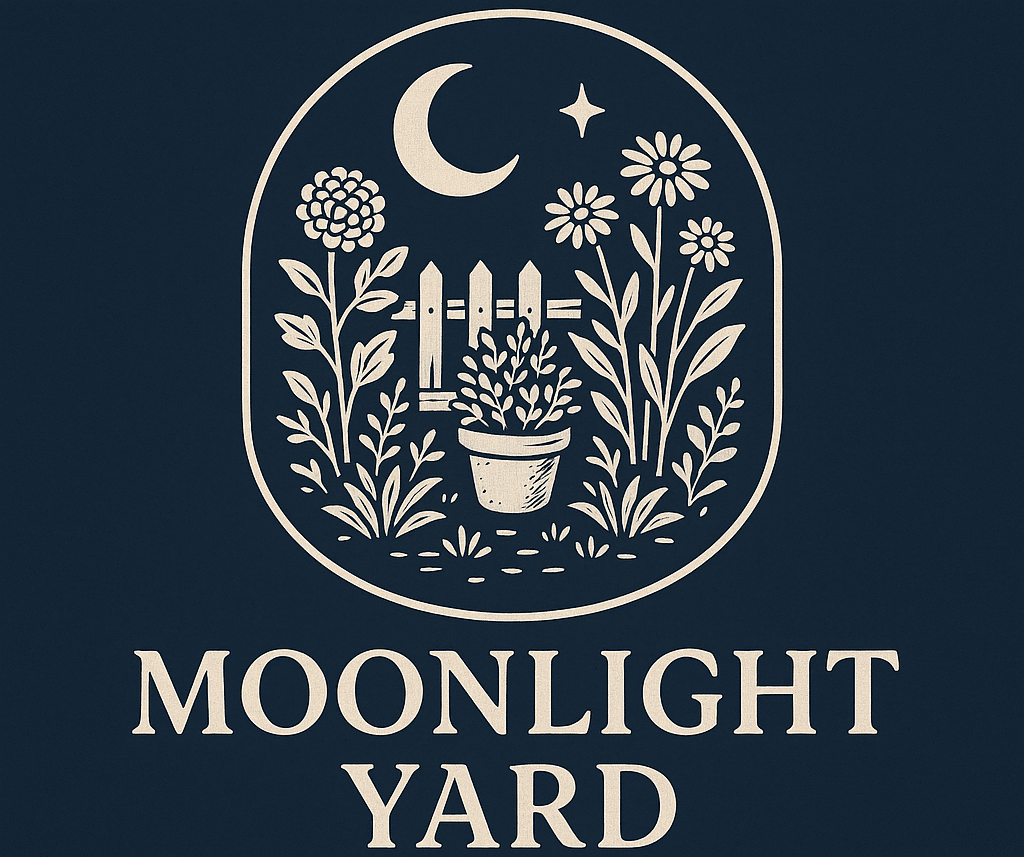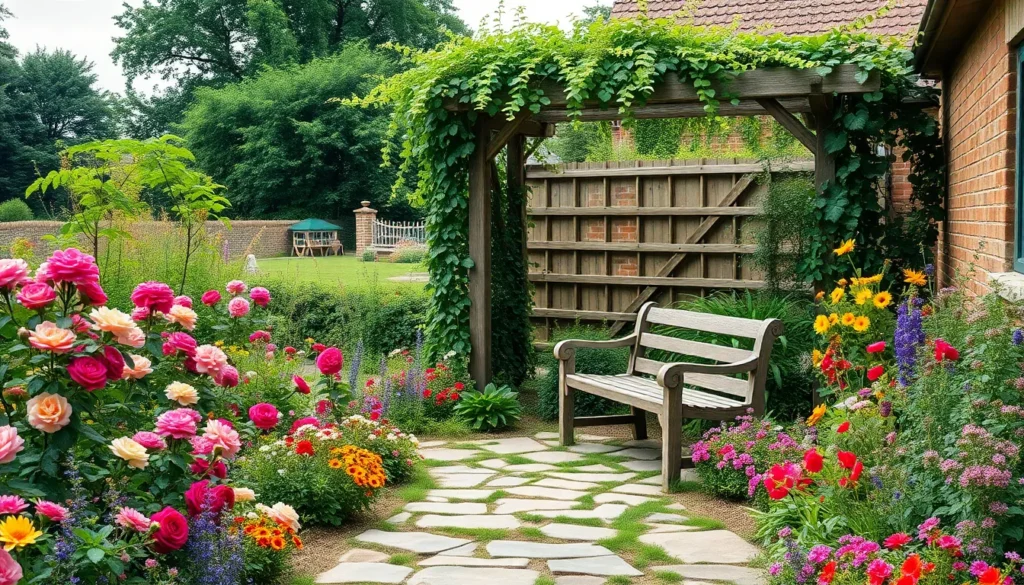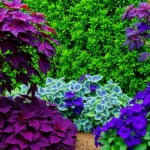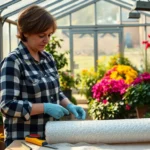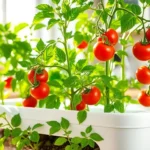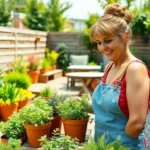We’ve all dreamed of creating that perfect country garden – a peaceful retreat where wildflowers dance in the breeze and rustic charm meets natural beauty. There’s something magical about transforming your outdoor space into a countryside haven that feels both timeless and welcoming.
Country gardens aren’t just about throwing seeds everywhere and hoping for the best. They’re carefully crafted spaces that blend cottage-style plantings with weathered materials and vintage touches. From picket fences adorned with climbing roses to gravel pathways lined with lavender we’ll show you how to capture that authentic farmhouse feel.
Whether you’re working with a sprawling backyard or a cozy corner plot we’ve gathered the most inspiring country garden ideas that’ll transform your space into a rural paradise. Let’s explore how simple elements like herb gardens stone borders and reclaimed wood can create the countryside escape you’ve been longing for.
Create a Charming Cottage Garden with Mixed Flower Borders
Mixed flower borders capture the essence of traditional country gardening through carefully orchestrated disorder. These plantings create the quintessential cottage garden atmosphere that transforms any outdoor space into a countryside haven.
Plant Heirloom Varieties for Authentic Country Appeal
Heirloom varieties bring generations of garden history to your country borders. Seeds passed down through families carry unique characteristics that modern hybrids often lack. We recommend starting with classic varieties like ‘Granny’s Bonnets’ columbines, ‘Love-in-a-Mist’ nigella, and heritage sweet peas for authentic cottage charm.
Traditional roses anchor cottage garden designs with their romantic presence. Varieties such as ‘Zephirine Drouhin’, ‘Madame Hardy’, and ‘Fantin-Latour’ offer disease resistance alongside old-fashioned fragrance. These climbers and shrub roses create vertical interest while maintaining the relaxed country aesthetic.
Heritage vegetables integrate seamlessly into mixed flower borders. Purple-topped turnips, scarlet runner beans, and rainbow chard provide both beauty and function. This practical approach mirrors historical cottage gardens where every plant served multiple purposes.
Design Informal Planting Schemes with Natural Flow
Curved borders mimic nature’s organic patterns better than rigid geometric shapes. We create flowing lines using a garden hose to mark boundaries before planting. These gentle curves guide the eye naturally through the garden space while accommodating the sprawling growth habits of cottage plants.
Layered heights build visual depth without formal structure. Plant tall delphiniums and hollyhocks at the back, medium foxgloves and peonies in the center, and low alyssum and violas at the front. This tiered approach ensures every plant receives adequate sunlight while creating ever-changing visual interest.
Repetition of key plants unifies the informal design throughout the border. We scatter the same varieties in groups of three or five across different sections. This technique creates rhythm while maintaining the casual, unplanned appearance that defines country garden style.
Incorporate Self-Seeding Annuals for Effortless Beauty
Self-seeding annuals reduce maintenance while increasing garden spontaneity. Plants like calendula, cornflowers, and poppies drop seeds naturally, creating surprise combinations each growing season. This natural regeneration process embodies the effortless beauty of traditional country gardens.
Annual flowers fill gaps between perennials during establishment years. Fast-growing varieties such as cosmos, zinnias, and marigolds provide immediate color while slower perennials develop their root systems. These quick bloomers ensure continuous interest throughout the gardening season.
Native wildflowers attract beneficial insects while maintaining regional authenticity. Black-eyed Susans, purple coneflowers, and wild bergamot support local wildlife populations. These hardy natives require minimal care once established, perfectly matching the low-maintenance philosophy of country garden design.
Build Rustic Garden Structures Using Natural Materials

Natural materials like wood, stone, and vines create the foundation for authentic country garden structures. These elements transform ordinary outdoor spaces into charming countryside retreats that feel both timeless and inviting.
Construct Weathered Wood Fencing and Gates
Weathered wood fencing creates an instant aged appearance that complements natural surroundings perfectly. We recommend selecting cedar, pine, or reclaimed barn wood for their durability and authentic country character.
Natural weathering processes give wood its distinctive gray patina and rustic texture over time. You can accelerate this process by applying weathering stains or letting nature take its course for genuine authenticity. Split rail fencing works exceptionally well for larger properties, while picket fencing suits smaller garden spaces.
Gates should match your fencing material and style for seamless visual flow. Consider adding decorative hardware like wrought iron hinges or vintage latches to enhance the country aesthetic. Position gates strategically to frame garden views and create natural entry points into different garden rooms.
Install Stone or Brick Pathways for Country Charm
Stone pathways provide durable surfaces while maintaining classic country charm throughout your garden. Flagstone, fieldstone, and limestone offer natural color variations that complement planted areas beautifully. We suggest choosing locally sourced materials to ensure your pathways blend harmoniously with regional industry characteristics.
Brick pathways create warm, traditional surfaces that age gracefully in country garden settings. Reclaimed bricks add immediate character with their weathered surfaces and unique color variations. Herringbone, basket weave, and running bond patterns each offer distinct visual appeal for different garden styles.
Installation techniques vary between materials but generally require proper base preparation and sand leveling. Allow small gaps between stones or bricks for moss growth and natural settling. This creates the informal, lived in appearance that defines authentic country gardens.
Add Pergolas and Arbors for Vertical Interest
Pergolas provide shaded areas while creating dramatic vertical elements in country garden designs. We build ours using cedar, oak, or pressure treated lumber for longevity in outdoor conditions. Standard dimensions range from 8×10 feet to 12×16 feet depending on available space and intended use.
Arbors frame garden entrances and support climbing plants for added natural beauty. Position them over pathways, gates, or seating areas to create intimate garden rooms. Simple post and beam construction works well for DIY projects, while more elaborate designs may require professional installation.
Climbing plants transform these structures into living architecture throughout growing seasons. Roses, clematis, grape vines, and honeysuckle provide seasonal color, fragrance, and wildlife habitat. We recommend planting at least two different climbing species for extended bloom periods and visual interest.
Establish a Traditional Vegetable and Herb Garden
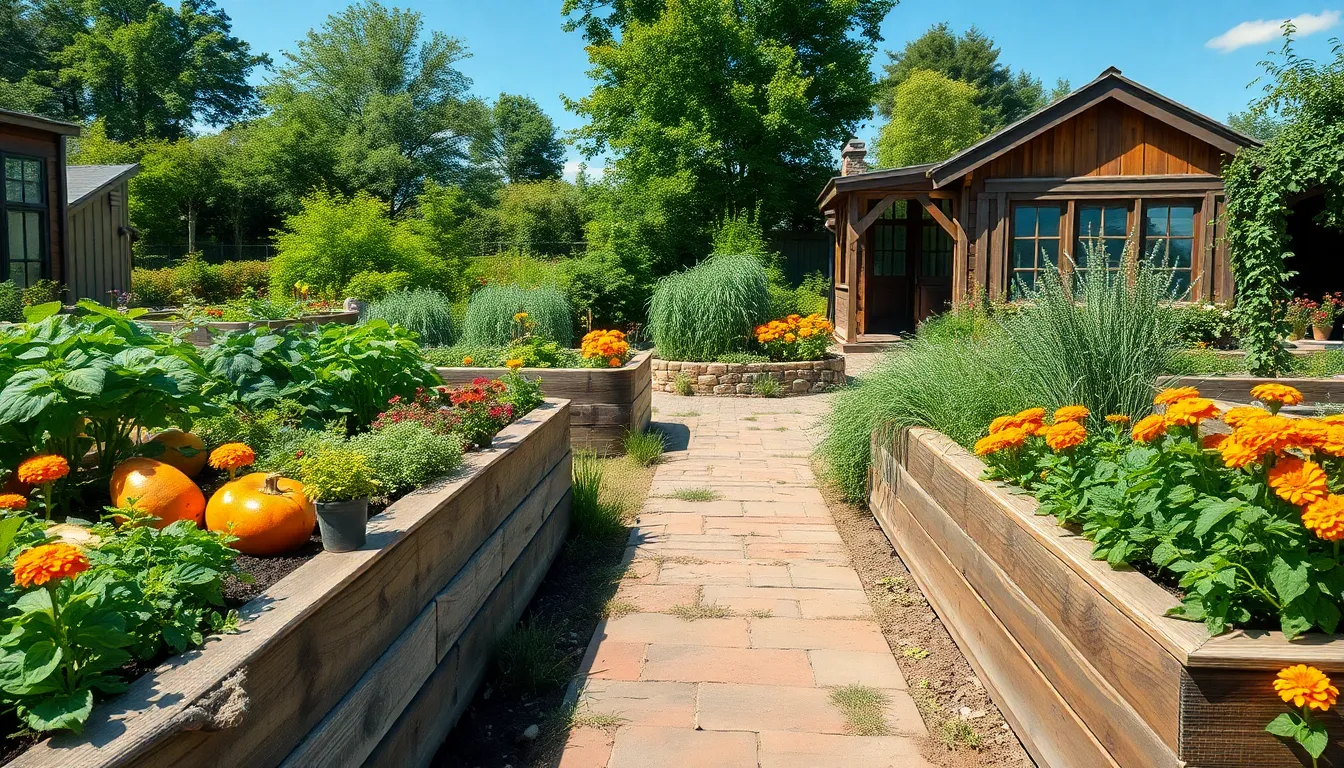
Growing your own food creates the heart of any authentic country garden. We’ll transform your outdoor space into a productive haven that combines beauty with functionality.
Design Raised Beds with Rustic Edging Materials
Build raised beds using natural materials like cedar or reclaimed barn wood to create that weathered country aesthetic. Wood planks aged by weather develop the perfect patina that complements your cottage garden’s rustic charm.
Stone edging adds timeless appeal to vegetable plots while providing excellent drainage and heat retention for root vegetables. Fieldstone, limestone, or recycled brick creates borders that last decades with minimal maintenance.
Brick pathways between beds offer classic country garden navigation while preventing soil compaction. Local clay bricks or salvaged materials from old buildings bring authentic character to your growing space.
Mix materials for visual interest by combining wood frames with stone corners or brick accents. This layered approach mirrors traditional farmstead gardens where materials were sourced from whatever was available locally.
Plant Heritage Vegetables and Culinary Herbs
Heirloom tomatoes provide exceptional flavor and connect us to gardening traditions passed down through generations. Cherokee Purples, Brandywines, and Black Krims offer superior taste compared to modern hybrids.
Heritage beans climb rustic trussles while producing pods with unique colors and textures that enhance both garden beauty and dinner plates. Dragon Tongue, Cherokee Trail of Tears, and Jacob’s Cattle varieties showcase stunning patterns.
Culinary herbs thrive in country gardens where they’re easily accessible for daily cooking needs. Plant basil, rosemary, thyme, and sage in dedicated herb beds or mixed throughout vegetable rows.
Root vegetables anchor autumn harvests with varieties like Purple Top turnips, Detroit Dark Red beets, and Chantenay carrots providing storage crops for winter months.
Create Companion Planting Combinations
Marigolds planted with tomatoes deter nematodes while adding bright orange and yellow blooms throughout the growing season. This traditional pairing protects plants naturally without chemical interventions.
Basil grows alongside tomatoes to improve flavor development and repel common pests like aphids and hornworms. Plant basil between tomato transplants for maximum benefit.
Three Sisters plantings combine corn, beans, and squash in the Native American tradition where each plant supports the others’ growth. Corn provides climbing support, beans fix nitrogen, and squash shades soil to retain moisture.
Herb spirals maximize growing space while creating microclimates for different plant needs. Mediterranean herbs like rosemary and lavender thrive at the sunny top, while moisture loving parsley and chives flourish at the base.
Checkerboard patterns alternate vegetables with flowers to confuse pests and attract beneficial insects throughout your country garden beds.
Incorporate Vintage and Repurposed Garden Elements
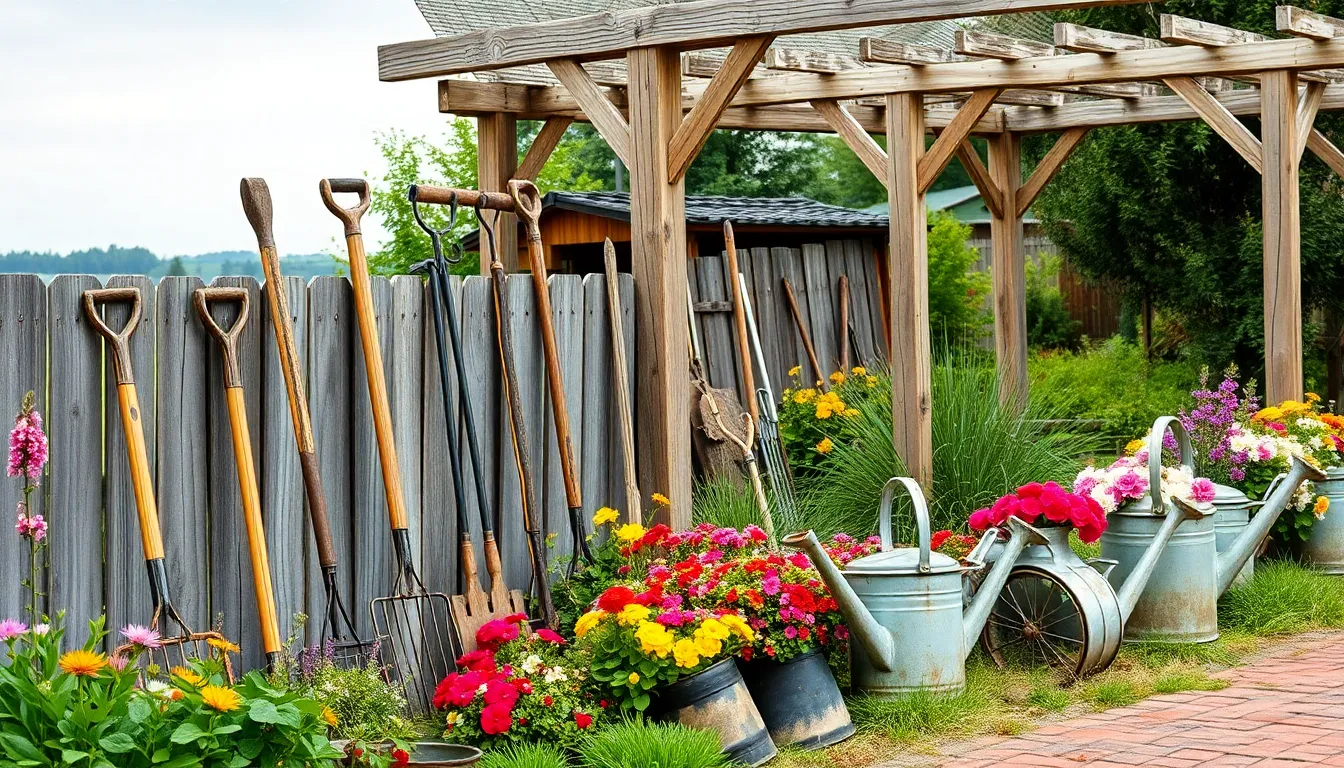
We can transform our country garden into a charming countryside retreat by incorporating weathered antiques and repurposed items that tell stories of bygone eras. These elements add authentic character while creating focal points that complement our rustic garden structures and traditional plantings.
Use Antique Farm Tools as Garden Decorations
Antique farm tools serve as perfect decorative elements that celebrate our agricultural heritage while adding rustic appeal to garden spaces. We can hang old rakes, shovels, and pitchforks from our weathered wood fences or lean them against garden walls to create striking visual displays. These weathered implements work especially well when grouped together near garden gates or positioned alongside our stone pathways.
Vintage hay forks and cultivators make excellent vertical accents when propped against pergola posts or arbor supports. We’ll find that positioning these tools near our heritage vegetable beds creates a cohesive theme that connects past farming traditions with our modern country garden design.
Transform Old Containers into Unique Planters
Old containers offer endless possibilities for creating distinctive planters that enhance our cottage garden aesthetic. We can repurpose vintage tin watering cans by drilling drainage holes and filling them with colorful flowers like heritage sweet peas or traditional roses. These charming vessels look particularly striking when clustered together along our brick pathways or positioned near garden benches.
Vintage enamelware pots bring authentic country charm when planted with culinary herbs like basil, thyme, or sage from our herb garden collection. We’ll discover that old wooden crates work wonderfully as raised planters for succulents or smaller heritage vegetables, especially when positioned near our rustic garden structures.
Galvanized buckets and old milk jugs can house our self-seeding annuals, creating mobile garden displays that we can rearrange seasonally to complement our mixed flower borders.
Display Vintage Signs and Country Collectibles
Vintage signs create compelling focal points that guide visitors through our country garden while adding nostalgic character to outdoor spaces. We can hang old farm signs, weathered directional markers, or antique advertising boards on our picket fences or pergola posts to establish distinct garden zones. These signs work particularly well when positioned near transitions between our vegetable beds and flower borders.
Country collectibles like antique tools, old wagons, and weathered metalware serve as conversation pieces that enhance our garden’s storytelling appeal. We’ll find that positioning vintage wheelbarrows filled with seasonal plantings creates mobile displays that complement our stone borders and curved pathways.
Old concrete garden fixtures such as weathered statues, birdbaths, and decorative urns discovered at estate sales add permanent sculptural elements to our industry design. These pieces work best when integrated naturally among our native wildflowers or positioned as anchoring points within our informal planting schemes.
Add Classic Country Garden Features and Focal Points

Authentic country gardens rely on timeless elements that blend functionality with rustic charm. These carefully chosen features create the peaceful ambiance that makes countryside retreats so inviting.
Install a Traditional Well or Water Feature
Traditional wells serve as stunning centerpieces that instantly transport visitors to simpler times. We recommend installing decorative wells made from natural stone or weathered wood that complement your garden’s existing materials. Ponds create soothing sounds while providing habitat for beneficial wildlife like frogs and dragonflies. Streams meandering through the industry add movement and tranquility to any outdoor space.
Water features don’t require elaborate plumbing systems to make an impact. Simple wells can function as planters filled with cascading flowers like petunias or trailing ivy. Installing a recirculating pump transforms basic water containers into bubbling fountains that mask neighborhood noise. Consider positioning these focal points where they’re visible from your home’s main gathering areas.
Create Cozy Seating Areas with Rustic Benches
Rustic benches invite relaxation while maintaining the authentic country aesthetic we’re cultivating. Natural materials like cedar, oak, or reclaimed barn wood create durable seating that weathers beautifully over time. We suggest positioning benches near fragrant herb gardens or flower borders where visitors can enjoy seasonal scents.
Stone benches offer permanent seating answers that blend seamlessly with natural hardscaping elements. Curved benches encourage intimate conversations while straight designs accommodate larger groups during garden parties. Adding weather resistant cushions in natural fabrics like burlap or canvas enhances comfort without compromising the rustic appeal.
Strategic placement maximizes these seating areas’ impact throughout your industry. Morning sun spots work perfectly for coffee breaks while shaded afternoon locations provide respite during hot summer days. Consider installing multiple small seating areas rather than one large space to create intimate garden rooms.
Build a Charming Garden Shed or Potting Station
Garden sheds combine practical storage with architectural interest that enhances your country garden’s charm. We recommend constructing these structures using natural materials like cedar shingles, barn wood siding, or stone foundations that echo your home’s exterior. Small sheds measuring 8×10 feet provide ample storage for tools, pots, and seasonal decorations.
Potting stations offer dedicated workspace for transplanting seedlings and arranging fresh cut flowers. Built in work surfaces using butcher block or reclaimed wood create functional areas for garden tasks. Installing hooks, shelves, and cubbies keeps essential supplies organized and easily accessible.
Weathered finishes help new structures blend naturally into established landscapes. Staining wood with gray or brown tones mimics aged barn materials while copper gutters develop attractive patina over time. Consider adding window boxes or climbing roses to soften hard edges and integrate these buildings into your overall garden design.
Design Natural Wildlife Habitats and Pollinator Gardens
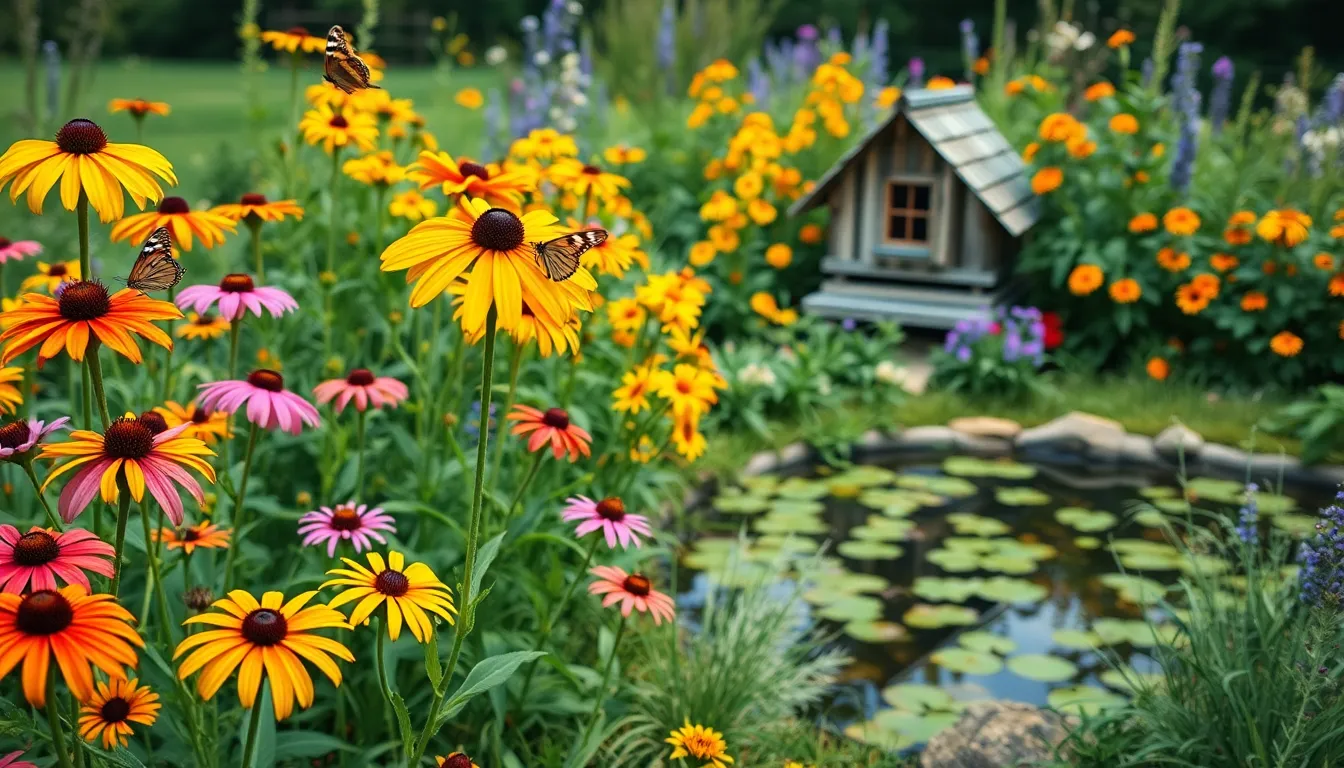
Creating wildlife habitats transforms our country gardens into thriving ecosystems that support local biodiversity. We’ll establish spaces where beneficial insects, birds, and small animals can flourish naturally.
Plant Native Wildflowers for Local Network Support
Native wildflowers form the foundation of successful wildlife habitats in our country gardens. We recommend incorporating a diverse mix of native plants and wildflowers that are naturally adapted to local climate and soil conditions. Milkweeds and umbellifers serve as excellent choices for attracting pollinators while supporting local biodiversity.
Ecoregion-exact plants ensure the highest success rates for our wildlife gardens. We select species that thrive in our particular geographic area, as these plants provide essential food and shelter for local wildlife throughout the growing season. Native plants require less water and maintenance compared to non-native alternatives, making them perfect for sustainable country garden designs.
Wildflower meadows create stunning visual displays while serving important ecological functions. We plant clusters of native wildflowers in informal drifts to mimic natural growing patterns, which appeals to both wildlife and the human eye.
Install Bird Houses and Feeding Stations
Bird houses provide essential nesting sites for various species throughout our country gardens. We position these structures in areas with natural shelter and nearby food sources to encourage occupation. Different bird species require exact house dimensions and entrance hole sizes, so we install multiple types to accommodate diverse feathered visitors.
Feeding stations attract year-round bird activity with diverse food offerings. We set up multiple feeding stations throughout the garden, each offering different seed types, suet, and fresh water. Strategic placement near natural cover allows birds to feed safely while providing us with excellent viewing opportunities.
Water features enhance our bird-friendly habitats significantly. We add small ponds or shallow pools surrounded by water-loving plants like willows and sedges to attract frogs, toads, and various bird species for drinking and bathing.
Create Butterfly Gardens with Nectar-Rich Plants
Nectar-rich flowers serve as vital fuel sources for adult butterflies in our country gardens. We plant abundant clusters of coneflowers and black-eyed Susans to provide essential nutrients throughout the growing season. These perennial favorites bloom for extended periods, ensuring consistent nectar availability.
Host plants support complete butterfly life cycles by providing nursery sites for caterpillars. We incorporate milkweed varieties specifically for monarch butterflies, as these plants serve as the exclusive host for monarch larvae. Native host plants ensure that butterfly populations can reproduce successfully in our gardens.
Butterfly garden design focuses on creating sunny, sheltered areas with diverse bloom times. We arrange plants in groups of three to five specimens for maximum visual impact and feeding efficiency, ensuring butterflies can easily locate and access nectar sources throughout the season.
Establish Orchard Areas and Fruit Growing Spaces
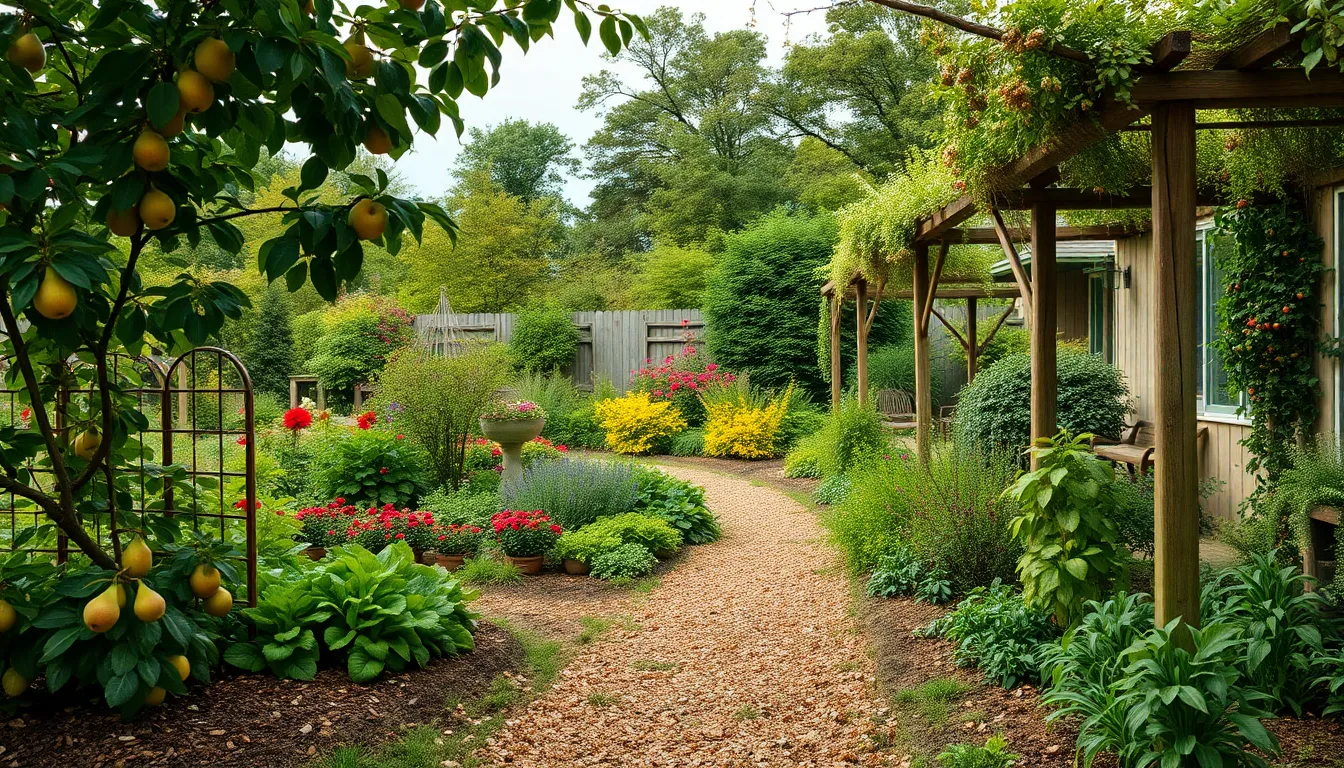
Creating productive orchards and fruit growing spaces brings both beauty and bounty to our country garden design. These food producing areas become stunning focal points while providing fresh harvests throughout the growing season.
Plant Heritage Fruit Trees in Informal Arrangements
Heritage fruit trees form the backbone of our country orchard with their natural, rustic appearance. We recommend planting these traditional varieties in informal arrangements rather than rigid rows to create an authentic countryside feel.
Apple trees like ‘Cox’s Orange Pippin’ and ‘Gravenstein’ offer unique flavors and historical significance that modern varieties can’t match. Pear trees such as ‘Bartlett’ and ‘Bosc’ add vertical interest while producing exceptional fruit for fresh eating and preserving.
Peach trees bring stunning spring blossoms followed by sweet summer harvests when we choose cold hardy varieties suited to our local climate. Spacing these fruit trees 15 to 20 feet apart allows for natural growth patterns while ensuring adequate air circulation.
Mixed plantings of different fruit species ensure continuous harvests from early summer through late fall. This approach also supports biodiversity by attracting various beneficial insects and providing diverse habitats for wildlife.
Design Berry Patches with Natural Supports
Berry patches thrive when we design them with natural materials and informal layouts that complement our country garden aesthetic. Natural supports using twigs, branches, and wooden trellises create functional growing structures while maintaining rustic charm.
Raspberry bushes benefit from simple wooden post and wire systems that we can construct using cedar or locust posts. Blackberry canes need sturdy trellises made from natural materials that can support heavy fruit loads during harvest season.
Blueberry bushes grow beautifully in informal clusters without requiring elaborate support systems. We plant them in groups of three to five bushes to ensure proper cross pollination and maximum fruit production.
Creating pathways between berry rows using wood chips or straw allows easy access for harvesting while suppressing weeds naturally. This informal layout lets plants grow freely while maintaining the productive capacity of our berry patches.
Create Herb Spirals and Edible Landscaping
Herb spirals maximize growing space while creating visually appealing focal points in our country garden design. We construct these spirals using stones or brick to form raised planting areas that accommodate herbs with different water and sun requirements.
Building spirals approximately 6 feet in diameter provides adequate space for 15 to 20 different herb varieties. Mediterranean herbs like rosemary, thyme, and oregano thrive in the well drained upper sections of our spiral design.
Moisture loving herbs such as parsley, chives, and mint flourish in the lower, shadier portions where water naturally collects. This vertical gardening technique creates microclimates that support diverse herb collections in compact spaces.
Edible landscaping integrates productive plants throughout our garden design rather than confining them to separate vegetable plots. We incorporate leafy greens, colorful vegetables, and flowering herbs into mixed borders alongside ornamental plants.
Kale, Swiss chard, and lettuce varieties add texture and color to flower beds while providing fresh salads throughout the growing season. Nasturtiums, calendulas, and other edible flowers bring vibrant colors while attracting beneficial pollinators to our garden network.
Use Country-Style Garden Lighting and Accessories
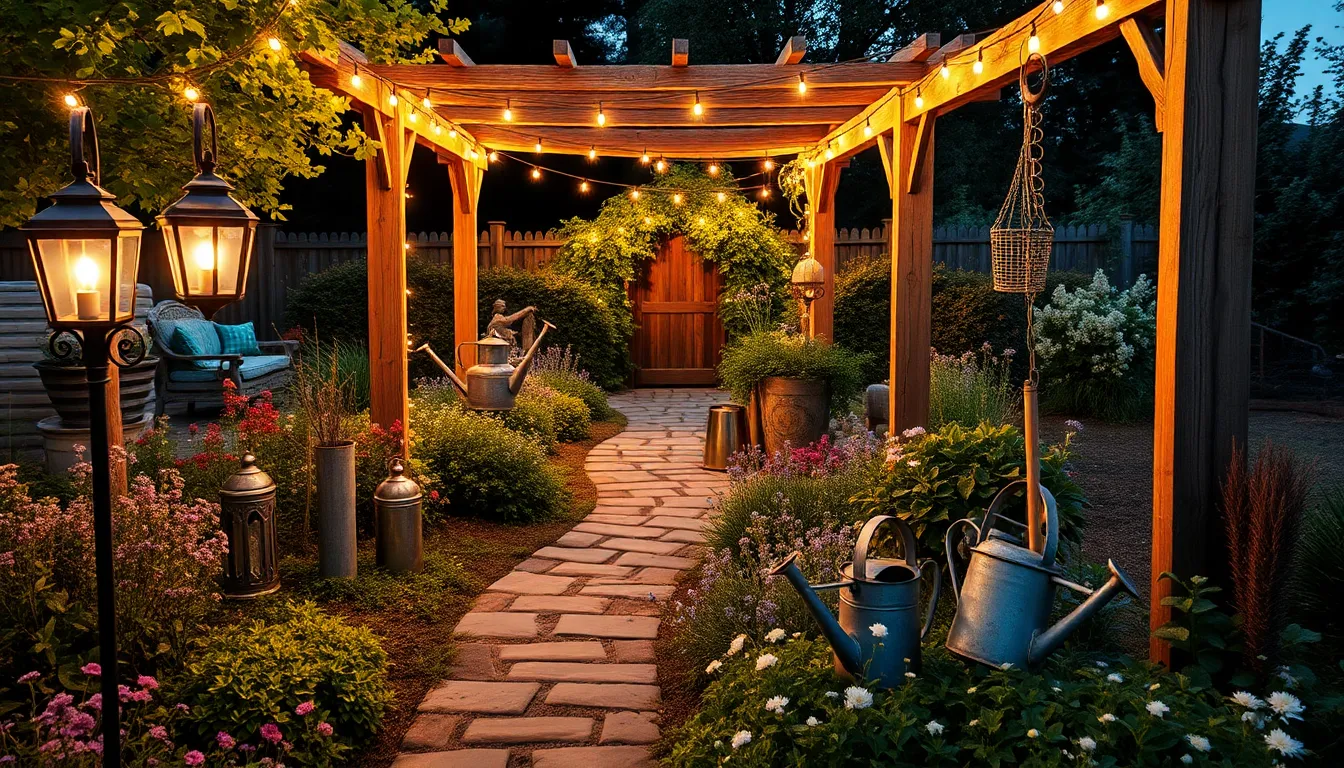
Transform your country garden into an enchanting evening retreat with carefully selected lighting and accessories. These elements create the perfect ambiance while maintaining that rustic charm we’ve been cultivating throughout our garden design.
Install Solar Lanterns and String Lights
Solar lanterns bring warmth and character to your garden pathways and seating areas during twilight hours. We recommend positioning these eco-friendly fixtures along stone walkways and near rustic benches to create a cozy atmosphere. String lights draped between pergola posts or wrapped around mature tree branches add magical illumination that extends your garden enjoyment well into the evening.
Choose lanterns with weathered finishes that complement your existing garden structures. Solar powered options eliminate the need for electrical wiring while providing sustainable lighting answers. String lights with Edison bulb styles enhance the vintage aesthetic we’ve established with our cottage plantings and heritage vegetables.
Add Weathered Metal Garden Art and Sculptures
Weathered metal sculptures serve as stunning focal points that echo the rustic materials used in our garden structures. Old farm tools transformed into decorative art pieces connect beautifully with the agricultural heritage of country garden design. Metal animal sculptures nestled among wildflower plantings create delightful discoveries for visitors exploring your garden paths.
Position larger sculptures near the entrance to your herb spiral or beside water features for maximum visual impact. Smaller weathered pieces work wonderfully when tucked between perennial borders or displayed on vintage potting benches. These sculptural elements develop beautiful patina over time, becoming even more authentic looking as seasons pass.
Place Vintage Watering Cans and Garden Tools
Vintage watering cans create nostalgic charm when strategically placed throughout your country garden industry. We suggest positioning these pieces near herb gardens where they serve both decorative and functional purposes. Antique garden tools leaning against potting sheds or hanging from pergola supports reinforce the working garden aesthetic.
Group vintage containers at different heights to create visual interest around seating areas and entrance gates. Enamelware pots filled with seasonal plantings add cottage garden appeal while maintaining practical growing space. These authentic pieces tell stories of generations past while seamlessly integrating with our modern country garden design approach.
Conclusion
Country gardens offer us the perfect opportunity to create outdoor spaces that celebrate both beauty and functionality. By embracing rustic materials weathered wood stone pathways and heritage plants we can create gardens that feel authentically connected to the countryside.
The key to success lies in balancing structure with natural informality. Whether we’re incorporating cottage-style borders installing vintage accessories or creating wildlife habitats each element should work together to support our garden’s overall charm and productivity.
Remember that the most enchanting country gardens develop character over time. As our plants mature pathways weather and climbing roses establish themselves our gardens will naturally evolve into the peaceful countryside retreats we’ve envisioned.
Frequently Asked Questions
What makes a country garden different from other garden styles?
Country gardens blend rustic charm with natural beauty, featuring informal planting schemes, cottage-style plantings, and weathered materials. Unlike formal gardens, they emphasize natural flow with curved borders, mixed flower and vegetable plantings, and vintage elements like reclaimed wood and antique tools for an authentic countryside feel.
What are the best plants for a traditional country garden?
Heirloom varieties are ideal, including ‘Granny’s Bonnets’ columbines, heritage sweet peas, and traditional roses. Native wildflowers, self-seeding annuals, culinary herbs like basil, and heritage vegetables such as heirloom tomatoes create the perfect mix of beauty and functionality in country gardens.
How do I create rustic garden structures for my country garden?
Use natural materials like cedar, reclaimed barn wood, and local stone. Build weathered wood fencing, install stone pathways, and add pergolas or arbors for vertical interest. These structures should support climbing plants and blend seamlessly with the garden’s natural, informal aesthetic.
What are the benefits of raised beds in country gardens?
Raised beds with rustic edging materials like cedar or reclaimed barn wood provide better drainage, soil control, and easier maintenance. They’re perfect for growing heritage vegetables and herbs while maintaining the garden’s rustic charm and organized appearance within an informal design.
How can I incorporate vintage elements into my country garden?
Use antique farm tools as decorative elements by hanging them on fences or walls. Transform old containers like vintage watering cans and enamelware pots into unique planters. Add weathered metal garden art, old wheelbarrows as planters, and rustic benches for authentic countryside character.
What wildlife-friendly features should I include in my country garden?
Plant native wildflowers to attract pollinators, install birdhouses and feeding stations, and create water features for local wildlife. Design butterfly gardens with nectar-rich plants and host plants, ensuring diverse bloom times throughout the season to support various species and biodiversity.
How do I design productive fruit-growing areas in a country garden?
Plant heritage fruit trees in informal arrangements rather than formal rows. Create mixed plantings of different fruit species for continuous harvests. Design berry patches with natural supports and informal layouts, and consider herb spirals to maximize growing space while maintaining rustic charm.
What lighting and accessories work best for country gardens?
Install solar lanterns and string lights for cozy evening ambiance. Choose weathered metal sculptures and garden art that complement the rustic theme. Display vintage watering cans and old garden tools as decorative elements to reinforce the working garden aesthetic and nostalgic countryside feel.
